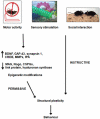Activity-dependent plasticity and gene expression modifications in the adult CNS
- PMID: 22144945
- PMCID: PMC3226246
- DOI: 10.3389/fnmol.2011.00050
Activity-dependent plasticity and gene expression modifications in the adult CNS
Abstract
Information processing, memory formation, or functional recovery after nervous system damage depend on the ability of neurons to modify their functional properties or their connections. At the cellular/molecular level, structural modifications of neural circuits are finely regulated by intrinsic neuronal properties and growth-regulatory cues in the extracellular milieu. Recently, it has become clear that stimuli coming from the external world, which comprise sensory inflow, motor activity, cognitive elaboration, or social interaction, not only provide the involved neurons with instructive information needed to shape connection patterns to sustain adaptive function, but also exert a powerful influence on intrinsic and extrinsic growth-related mechanisms, so to create permissive conditions for neuritic remodeling. Here, we present an overview of recent findings concerning the effects of experience on molecular mechanisms underlying CNS structural plasticity, both in physiological conditions and after damage, with particular focus on activity-dependent modulation of growth-regulatory genes and epigenetic modifications.
Keywords: activity-dependent plasticity; enriched environment; epigenetics; experience; growth-regulatory cues; neuritic remodeling.
Figures


Similar articles
-
Influence of the environment on adult CNS plasticity and repair.Cell Tissue Res. 2012 Jul;349(1):161-7. doi: 10.1007/s00441-011-1293-4. Epub 2011 Dec 6. Cell Tissue Res. 2012. PMID: 22143260 Review.
-
Regulation of intrinsic neuronal properties for axon growth and regeneration.Prog Neurobiol. 2007 Jan;81(1):1-28. doi: 10.1016/j.pneurobio.2006.12.001. Epub 2006 Dec 22. Prog Neurobiol. 2007. PMID: 17234322 Review.
-
Experience-dependent plasticity and modulation of growth regulatory molecules at central synapses.PLoS One. 2011 Jan 31;6(1):e16666. doi: 10.1371/journal.pone.0016666. PLoS One. 2011. PMID: 21304956 Free PMC article.
-
Dynamic DNA methylation in the brain: a new epigenetic mark for experience-dependent plasticity.Front Cell Neurosci. 2015 Aug 25;9:331. doi: 10.3389/fncel.2015.00331. eCollection 2015. Front Cell Neurosci. 2015. PMID: 26379502 Free PMC article. Review.
-
The Emerging Concept of Intrinsic Plasticity: Activity-dependent Modulation of Intrinsic Excitability in Cerebellar Purkinje Cells and Motor Learning.Exp Neurobiol. 2018 Jun;27(3):139-154. doi: 10.5607/en.2018.27.3.139. Epub 2018 Jun 30. Exp Neurobiol. 2018. PMID: 30022866 Free PMC article. Review.
Cited by
-
Pathogenesis of cerebral palsy through the prism of immune regulation of nervous tissue homeostasis: literature review.Childs Nerv Syst. 2016 Nov;32(11):2111-2117. doi: 10.1007/s00381-016-3245-5. Epub 2016 Sep 14. Childs Nerv Syst. 2016. PMID: 27638717 Review.
-
Carotid body chemoreflex: a driver of autonomic abnormalities in sleep apnoea.Exp Physiol. 2016 Aug 1;101(8):975-85. doi: 10.1113/EP085624. Exp Physiol. 2016. PMID: 27474260 Free PMC article. Review.
-
SR-FTIR Biomolecular Characterization of the Hippocampus: The Role of Tenascin C in Adult Murine Neurogenesis in the Subgranular Zone.Cells. 2025 Mar 14;14(6):435. doi: 10.3390/cells14060435. Cells. 2025. PMID: 40136684 Free PMC article.
-
Use of water- and land-based gait training to improve walking capacity in adults with complete spinal cord injury: A pilot study.J Spinal Cord Med. 2024 May;47(3):404-411. doi: 10.1080/10790268.2022.2088507. Epub 2022 Jul 7. J Spinal Cord Med. 2024. PMID: 35796664 Free PMC article.
-
Temporal endurance of exercise-induced benefits on hippocampus-dependent memory and synaptic plasticity in female mice.Neurobiol Learn Mem. 2022 Oct;194:107658. doi: 10.1016/j.nlm.2022.107658. Epub 2022 Jul 8. Neurobiol Learn Mem. 2022. PMID: 35811066 Free PMC article.
References
LinkOut - more resources
Full Text Sources

